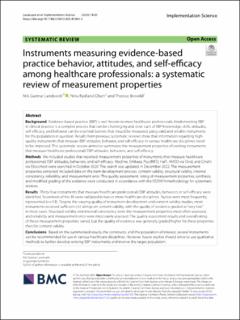| dc.description.abstract | Background Evidence-based practice (EBP) is well known to most healthcare professionals. Implementing EBP
in clinical practice is a complex process that can be challenging and slow. Lack of EBP knowledge, skills, attitudes,
self-efficacy, and behavior can be essential barriers that should be measured using valid and reliable instruments
for the population in question. Results from previous systematic reviews show that information regarding high-
quality instruments that measure EBP attitudes, behavior, and self-efficacy in various healthcare disciplines need
to be improved. This systematic review aimed to summarize the measurement properties of existing instruments
that measure healthcare professionals’ EBP attitudes, behaviors, and self-efficacy.
Methods We included studies that reported measurement properties of instruments that measure healthcare
professionals’ EBP attitudes, behaviors, and self-efficacy. Medline, Embase, PsycINFO, HaPI, AMED via Ovid, and Cinahl
via Ebscohost were searched in October 2020. The search was updated in December 2022. The measurement
properties extracted included data on the item development process, content validity, structural validity, internal
consistency, reliability, and measurement error. The quality assessment, rating of measurement properties, synthesis,
and modified grading of the evidence were conducted in accordance with the COSMIN methodology for systematic
reviews.
Results Thirty-four instruments that measure healthcare professionals’ EBP attitudes, behaviors or self-efficacy were
identified. Seventeen of the 34 were validated in two or more healthcare disciplines. Nurses were most frequently
represented (n = 53). Despite the varying quality of instrument development and content validity studies, most
instruments received sufficient ( +) ratings on content validity, with the quality of evidence graded as “very low”
in most cases. Structural validity and internal consistency were the measurement properties most often assessed,
and reliability and measurement error were most rarely assessed. The quality assessment results and overall rating
of these measurement properties varied, but the quality of evidence was generally graded higher for these properties
than for content validity.
Conclusions Based on the summarized results, the constructs, and the population of interest, several instruments
can be recommended for use in various healthcare disciplines. However, future studies should strive to use qualitative
methods to further develop existing EBP instruments and involve the target population. | en_US |

